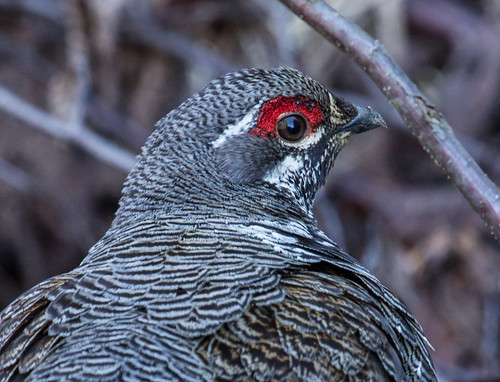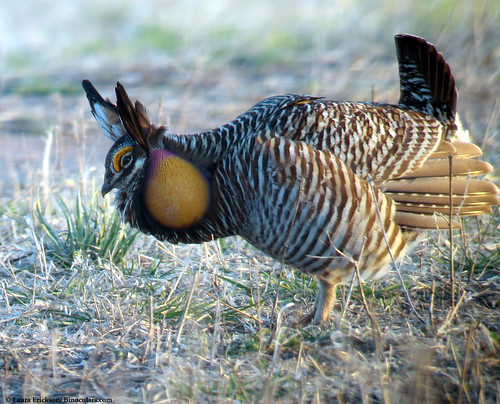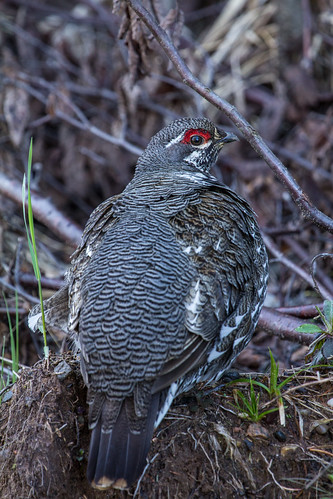
Spruce Grouse and other members of their family are national treasures, far more important in American history and culture, and for their role in the ecology of their respective habitats, than they are as game birds. Unfortunately, value is seldom judged by intangibles. As the number of hunters continues to dwindle, the Minnesota DNR in particular seems to bend over backward to make the remaining hunters happy, no matter what the cost to our conservation ethic.
The Spruce Grouse is listed as Threatened in Wisconsin, where none can be taken at any time of year. It’s also a fully protected Species of Special Concern in Michigan. Since 2006, Minnesota has listed it as a Species of Greatest Conservation Need, and it has been on the Chippewa National Forest’s sensitive species list since 2004. Yet in Minnesota, a great many are legally killed each year by hunters.
In 2008, the Association of Fish and Wildlife Agencies recommended that states still having Spruce Grouse habitat develop formal surveys for monitoring population change and conduct research on the effects of habitat alterations and hunting. Concerns about climate change causing a northward retreat, along with losses to auto collisions and, in some areas, habitat losses due to mining and other causes, make many people worry about the future of this magnificent bird. But despite our lack of standardized data about Spruce Grouse population trends, from 10,000 to 20,000 are taken each year by hunters in Minnesota. This isn’t many compared to the half million Ruffed Grouse taken each year, but is a significant take when we don’t have any handle on their actual numbers. In the hundred years since the Passenger Pigeon became extinct, we seem to have forgotten how quickly a population or even an astonishingly abundant species can disappear. Fortunately, the Minnesota DNR is starting what sound like some excellent programs for more systematic monitoring of Spruce Grouse, as was detailed in an article in the March-April 2014 Minnesota Conservation Volunteer by Jason Abraham, "A Search for Secrets of the Spruce Grouse." Unfortunately, that article includes some misleading information about the bird's diet, which changes in spring and summer to include a great many plants and berries as the grouse forage more on the ground. This is important, because savvy hunters realize that the birds taste better at the beginning of the hunting season, before spruce needles and buds start to dominate their diet again. Some Spruce Grouse taken by hunters in Minnesota are mistaken for the more delicious and more numerous Ruffed Grouse. It seems a shame to waste an opportunity for hunter education that can help prevent some wasted birds.

Interestingly, the state responded very quickly when Greater Prairie-Chickens started declining, but that was much closer in time to the disappearance of the Passenger Pigeon. In 1923, almost 329,000 Greater Prairie-Chickens were taken in Minnesota, but a mere two decades later, in 1942, that harvest was down to 58,000, and in fear that the species was disappearing, the state closed the hunting season on prairie chickens entirely in 1943. In 2013, a DNR survey found the total number of male Greater Prairie-Chickens in Minnesota in spring at 1,415, or perhaps a few more. Assuming males and females are about comparable in number, the total breeding population would be less than 3,000—far, far less than a tenth of the number harvested in 1942 when it was obvious that the species was in trouble.
Even though prairie chicken numbers in Minnesota are critically low, with the huge swings in numbers each year associated with surveys of tiny populations, a hunting season based on a lottery for special permits was opened in 2006. Participating in a lottery to hunt such a dangerously declining species seems to specifically select for those hunters who don't believe in limiting themselves to taking no more than any surplus population. When searching for population information, I came upon several mentions of the “Minnesota Grand Slam,” when a hunter manages to get a Ruffed Grouse, Spruce Grouse, Sharp-tailed Grouse, and Greater Prairie-Chicken all in the state in the same year--it was even promoted in that Minnesota Conservation Volunteer article. Why couldn’t they encourage people to set that as a photography goal rather than a hunting goal, when the prairie chicken and sharp-tail are both suffering dangerously low numbers and we don’t know what’s happening with Spruce Grouse numbers?
Ten years ago, Minnesota opened a Mourning Dove hunt 60 years after taking the bird off its list of game species. Never before have we opened a season on a bird whose only real management in the state has been by farmers and people who feed birds. Public comment during the decision-making was heated, with a huge outcry from people who saw no reason to open a season on a beloved backyard bird. The DNR claimed that 30,000–50,000 hunters would try dove hunting, but the actual numbers have been far fewer. The one lesson the DNR seemed to take from the dove hunt public outcry was to prevent public comment the next time they opened a season on what had been a non-game species. They opened a Sandhill Crane season in 2010 without any public input. Even today, May 26, 2014, they're using a Sandhill Crane as the poster child of the DNR's Nongame Wildlife Program page for the Northwest Region in the state--the very region in which they are now allowing Sandhill Crane hunting!
The Minnesota DNR has a very active Hunter Recruitment and Retention Program, but does little to nothing to promote its Nongame Wildlife Program short of giving taxpayers the option to contribute via the "chickadee checkoff" on our state tax forms. And by making it clear the DNR's true loyalties are to hunting, even going so far as to redesignate species that were non-game favorites as game birds, they have succeeded in alienating a great many people, including some of us non-hunters who have been huge proponents of the DNR.
I’d recently re-read Joel Greenberg’s book about the Passenger Pigeon, and got a sad shiver of recognition while reading that Minnesota Conservation Volunteer article about Spruce Grouse cited above, in the section titled "Fool Hen." “Reports abound of hunters approaching the birds and knocking them dead with a stick.” It seems we’ve entirely lost the very concept of sportsmanship when our official DNR magazine touts that kind of behavior in 2014.
Hunters voluntarily gave up hunting Wood Ducks in the early 1900s because their population was declining. Thanks to many people, the great majority of them hunters, working to restore habitat, they brought the species back, and Wood Duck numbers continue to rise. Ducks Unlimited has tried to match that excellent record with other waterfowl species, and does wonderfully. This should be the standard for hunter conservation. Instead, today in Minnesota we’re allowing the hunting of vanishing species and providing generous bag limits for species with no solid population data, adding non-game birds to the hunted species as if to make up for the fewer game birds remaining, and actually celebrating how easily hunters can club to death a beautiful bird with a stick. Where are the hunters who earned the sport its reputation for sportsmanship and conservation? And when will the Minnesota DNR recognize that non-hunters are also conservationists, and would happily support them if they gave even the slightest indication that they were listening to us?

